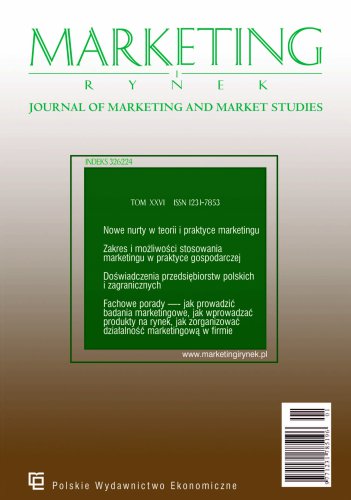Tap water consumption. Conclusions from sociological research in Poznań agglomeration
The aim of the article is to study the factors affecting the level of social trust in water quality. Currently, there is strong competition on the market for consumer preferences regarding water consumption: the choice between tap water or bottled water. For a long time, tap water was in an unfavorable market position in relation to bottled water. In recent years, however, we have seen a renewed interest in drinking tap water and an increase in awareness of the negative aspects of bottled water. In this context, the results of many years of sociological research conducted in the Poznań agglomeration in 2004–2021 are interesting, which showed an increase in the percentage of inhabitants of the Poznań agglomeration declaring drinking tap water without boiling it and a decrease in the percentage of those inhabitants who never drink unboiled tap water. The article focuses on two groups of factors influencing these percentages: the quality of water supplied by Aquanet, measured by objective physical, chemical, and biological parameters on the one hand and subjective social level of trust in water on the other. Systematic monitoring of water quality parameters in 2012–2021 proves that rigorous water standards are maintained in terms of chemical, physical and biological parameters. The second group of factors are the promotional campaigns conducted by the Aquanet company, shaping the social image of water and the social changes analyzed in the article, changes in consumption preferences related to the increase in the ecological awareness of the inhabitants. The analysis contained in the article does not exhaust the issue. However, it is sufficient to signal the marketing potential associated with a product without packaging, which is tap water.
References
Bibliografia/References
Abbasi, S. A. (2002). Water Quality Indices. State of the art report. National Institute of Hydrology, Scientific Contribution No. INCOH/SAR-25/2002, INCOH, 73.
Ansari, K., & Hemke, N. M. (2013). Water quality index for assessment of water samples of different zones in Chandrapur city. International Journal on Engineering Applications, 3(3), 233–237.
Avvannavar S. M., & Shrihari, S., (2008). Evaluation of water quality index for drinking purposes for river Netravathi, Mangalore, South India. Environmental Monitoring and Assessment, 143, 279–290. https://doi.org/10.1007/s10661-007-9977-7
Bywalec, C., & Rudnicki, L. (2002). Konsumpcja. PWE.
Boyacioglu, H. (2007). Development of a Water Quality Index based on a European classification scheme. Water SA, 33(1), 101–106. https://doi.org/10.4314/wsa.v33i1.47882
Cichocki, R., & Wechta, P. (2023). Społeczny wizerunek wody do picia. Studium socjologiczne. Wydawnictwo Naukowe Scholar.
Etzioni, A. (2003). Introduction: Voluntary Simplicity: Psychological Implications, Societal Consequences. W: D. Doherty, & A. Etzioni, Voluntary Simplicity. Responding to Consumer Culture. Rowan and Littlefield Publishers. https://doi.org/10.1007/978-3-662-03900-7_1
Hamilton, C., & Denniss, R. (2009). The Downshifters. W: S. Alexander (Red.), Voluntary Simplicity: The Poetic Alternative to Consumer Culture. Stead & Daughters.
Harrison, R., Newholm, D., & Shaw, D. (2005). Pressure groups, campaigns, and consumers. W: R. Harrison, T. Newholm, & D. Shaw (Red.), The Ethical Consumer. Sage. https://doi.org/10.4135/9781446211991
Horton, R. (1965). An index number system for rating water quality. Journal of the Water Pollution Control Federation, 37(3), 300–306.
House, M., & Ellis, J. B. (1980). Water quality indices (UK): An additional management tool? Progress in Water Technology, 13, 413–423.
Jan Paweł II. (1987). Sollicitudo rei socialis. Encyklika nr 29.
Jerzyk, E. (2014). Design opakowania i jego elementy w procesie podejmowania decyzji zakupowych. Marketing i Rynek, (4), 291–398.
Johnson, B. B. (2003). Do reports on drinking water quality affect customers' concerns? Experiments in report content. Risk Analysis, 23(5), 985–998. https://doi.org/10.1111/1539-6924.00375
Kasperek, A. (2016). Minimalistyczna duchowość jako przykład antykonsumpcjonistycznej duchowości: perspektywa socjologiczna. Zeszyty Naukowe Katolickiego Uniwersytetu Lubelskiego, (4), 71–88.
Kłos, L. (2017). Czy „kranówka” może stać się bezpiecznym substytutem wód butelkowanych? Studia i Prace WNEIZ US, (47/2), 77–87. https://doi.org/10.18276/SIP.2017.47/2-07
Kozik, N. (2019). Opakowanie jako narzędzie wpływania na wybory konsumentów i czytelność przekazywanych przez nie komunikatów na przykładzie ekskluzywnych wód mineralnych. Zeszyty Naukowe UEK, 4(982), 19–38. https://doi.org/10.15678/ZNUEK.2019.0982.0402
Mirek, J. (2009). Klasyfikacja wód mineralnych w świadomości konsumentów – wyniki badań własnych. Zeszyty Naukowe UEK, (800), 127–140.
Ottman, J. A. (2003). Green Marketing: Challenges and Opportunities for the New Marketing Age. NTC Business Books.
Pessel, W. (2010). Antropologia nieczystości. Studia z kultury sanitarnej Warszawy. Wydawnictwo Trio i Collegium Civitas.
Song, T., & Kim, K. (2009). Development of a water quality loading index based on water quality modelling. Journal of Environmental Management, 90(3), 1534–1543. https://doi.org/10.1016/j.jenvman.2008.11.008
Stewart, B. (2009). Projektowanie opakowań. Wydawnictwo Naukowe PWN.
Wang, E. S. T. (2013). The Influence of visual packaging on perceived food product quality, value, and brand preference. International Journal of Retail & Distribution Management, 41(10), 805–816. https://doi.org/10.1108/ijrdm-12-2012-0113

